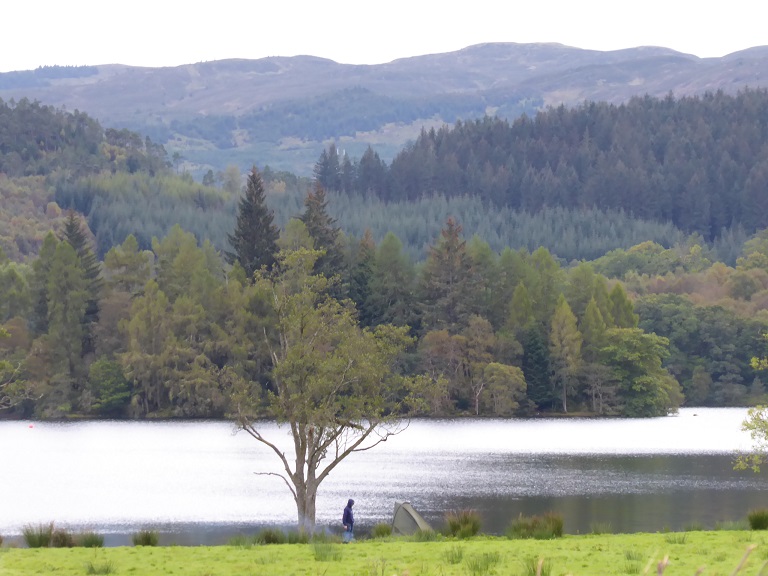
The camping byelaws in the Loch Lomond and Trossachs National Park cease to have effect from midnight tonight. Before then you commit a criminal offence if you “set up, use or occupy a tent, wigwam or bivouac at any time” within one the four “camping management zones” the Loch Lomond and Trossachs National Park Authority created three and a half years ago with the approval of Scottish Ministers. After mid-night your are free once again to choose where to camp with full access rights restored. To mark the end of this camping byelaw “season” I went to have a look at the only camping permit area I had not visited since they came into effect on March 1st 2016 – at Couligartan on Loch Ard near Aberfoyle. My visit provided another illustration of what is wrong with the camping byelaws.
The photo above illustrates perfectly the failure of the camping byelaws. Either people don’t know that putting up shelters such as this is illegal or they don’t care. Whatever the case, they are clearly impossible to enforce.
Its harder for the LLTNPA to prosecute people for putting up shelters because the no camping signs the LLTNPA has erected throughout the camping management fail to make it clear shelters as well as tents are illegal.
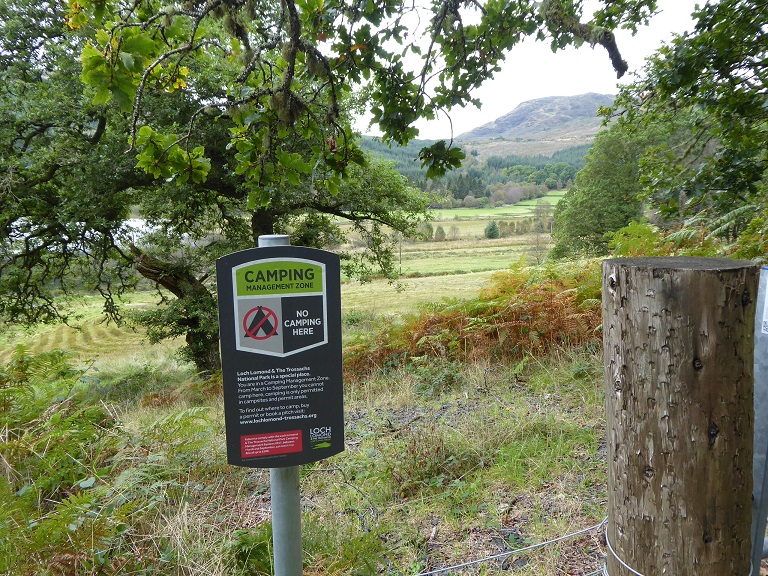
That did not stop them, however, from prosecuting a dedicated angler for doing what he enjoyed (see here). The way the byelaw have been enforced is arbitrary and unfair
The impression now, however, is the LLTNPA has given up their attempt to try and stop campervanners and fisherfolk from enjoying the National Park and have focussed their efforts solely on campers. Two thirds of their original intention and justification has collapsed.
Couligartan and the camping permit area
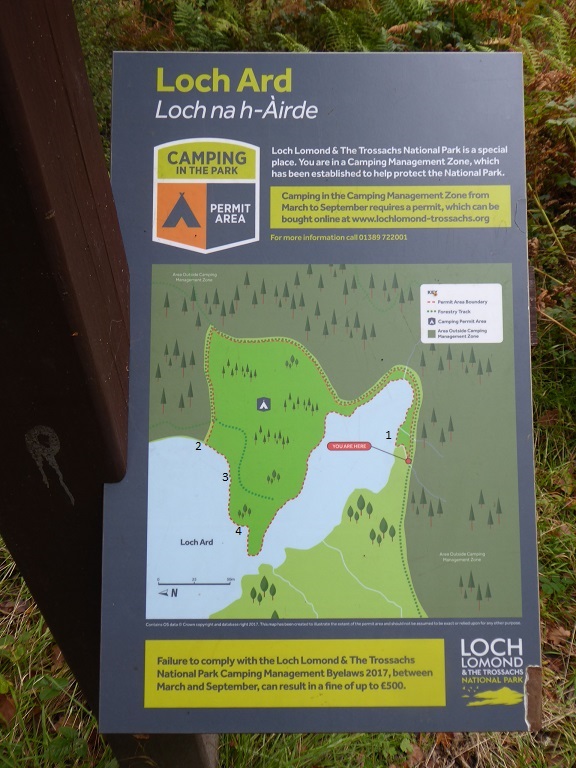
Luckily I checked the LLTNPA’s website BEFORE going to visit the Couligartan camping permit area and found that:

This means that at least two camping permit areas were out of action for the last 2 weeks of the camping byelaw season. Last year the LLTNPA reported to Scottish Ministers in their update report that they had just scraped the target for the 300 “new” camping places they had promised before the byelaws came into effect. That target will have been helped by the new campsite on Loch Achray which eventually opened a year late with 17 new pitches (not all were ready on 1st March). 300 places, however, was meant to be the minimum and a starting point for further development. That’s never happened.

We walked into the camping permit area from Kinlochard. Its about 2.5k to the edge of the area and, just behind the sign which sets out the dividing lines between where its lawful to camp from where you could be prosecuted, there is a space suitable for camping. Not a sign of forest operations in sight! So why did the LLTNPA have to close ALL of this camping permit area? There is no rhyme or reason for the decision. It appears its just easier to close the whole area than explain where forest operations are actually taking place. That’s what happens when access rights are removed and decisions are taken by people who have arbitrary authority. There is no means of recourse to this and had you camped here you would have been guilty of a criminal offence.

The rest of the bay is completely uncampable. The large green areas marked on the LLTNPA maps are a LIE, covered either by dense conifer forest, thick broadleaf tree regeneration or steep ground. In delineating camping permit areas three years ago the LLTNPA was desperate to convince Scottish Ministers and the public that it would allow sufficient places still for people to camp. Hence why the permit areas are relatively large on maps though, as parkswatch has shown, in many cases like here most of these zones are completely uncampable. If you were coming here without knowing the place and found people already camped in the first space, you could then spend a lot of time on a fruitless mission trying to find somewhere to camp.
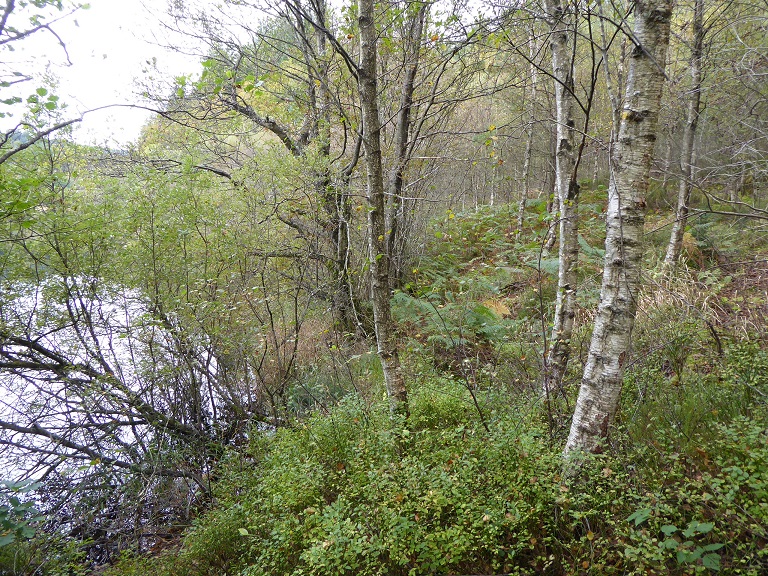
We bushwacked along the shore for a bit before giving up and returning to the forest track where, eventually, we did come across evidence of forest operations in the form of a new “upgraded”, i.e even uglier, forest track and a collection of signs
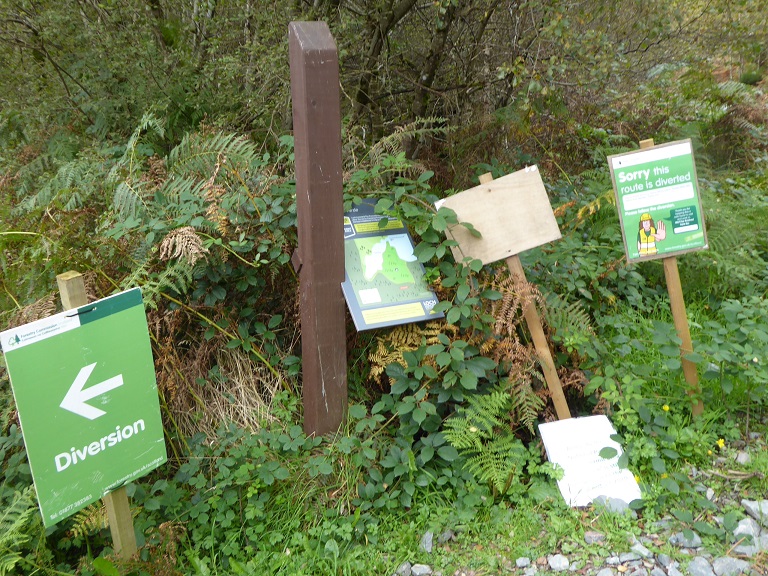
The sign on the ground indicated that access to the permit area was permitted till the end of August.
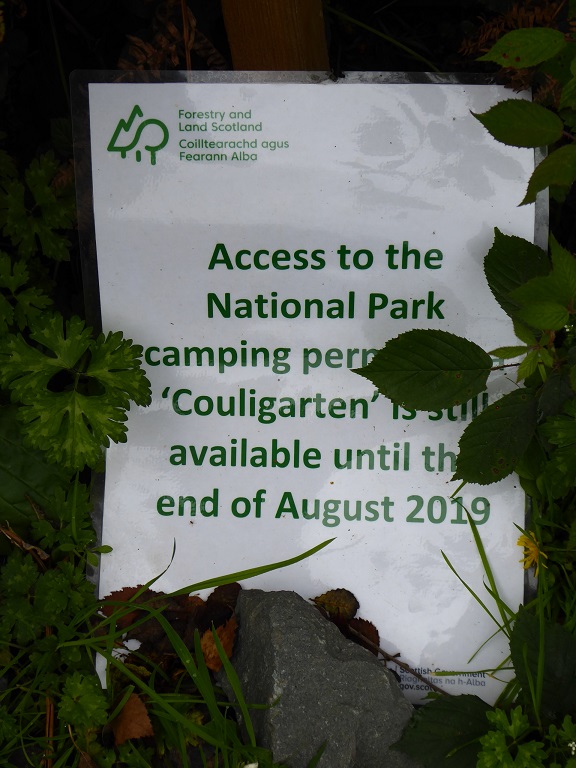
There was no sign of any forest operations taking place so we walked down the forest track which forms the boundary of the permit area. There were dense trees on either side with nowhere for camping until we reached a T-junction just above the loch. Below, there was a space amongst the trees where had camped.
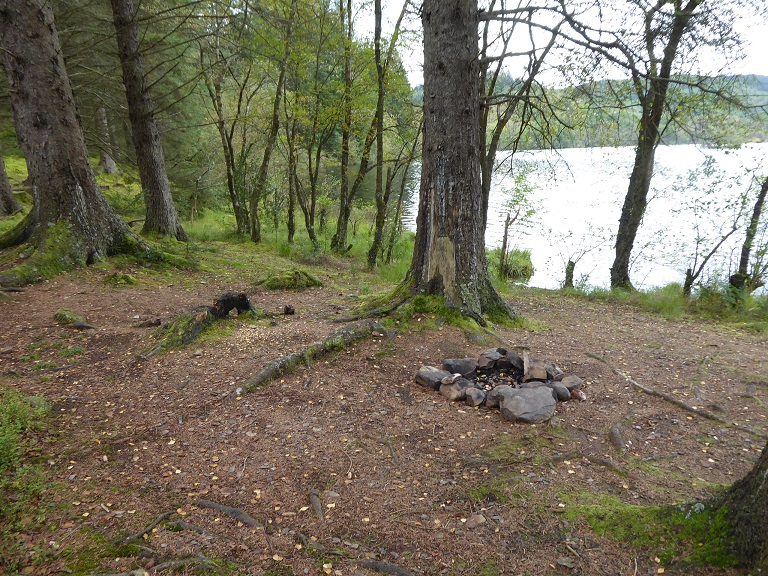
There was no good reason why anyone should not have camped here this last weekend as there was no danger at all from forest operations. Again, however, had you done so you would have committed a criminal offence because the LLTNPA had withdrawn the facility to buy permits for this area and without a permit you cannot lawfully camp.
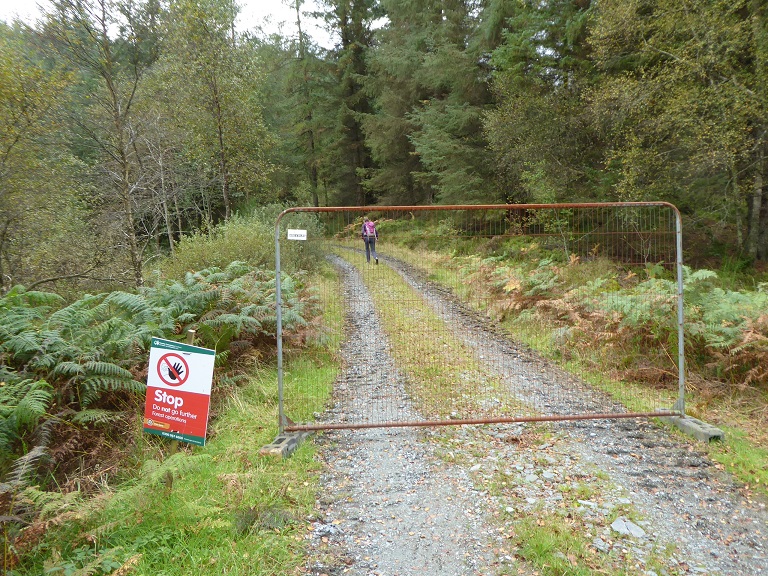
Under the Scottish Outdoor Access Code there is detailed guidance for signage about forest operations. Signage like this should ONLY be put up when work is actually taking place. There was no evidence of any such work and this sign was therefore up contrary to the SOAC and in ignoring it we were quite within our access rights. While you and I, however, have the right to submit a complaint about signs like this and get the local access authority to remove them, there is no right of redress to the Park’s decision to suspend the entire Couligarten camping permit area even though that decision was clearly contrary to the whole spirit of access rights. People should be able to camp here when forest operations are not taking place but the Park has decided otherwise and that is that.
Above this spur of the forest road the trees are too dense for any camping to be possible – the current forest operations are intended to thin out the trees there.
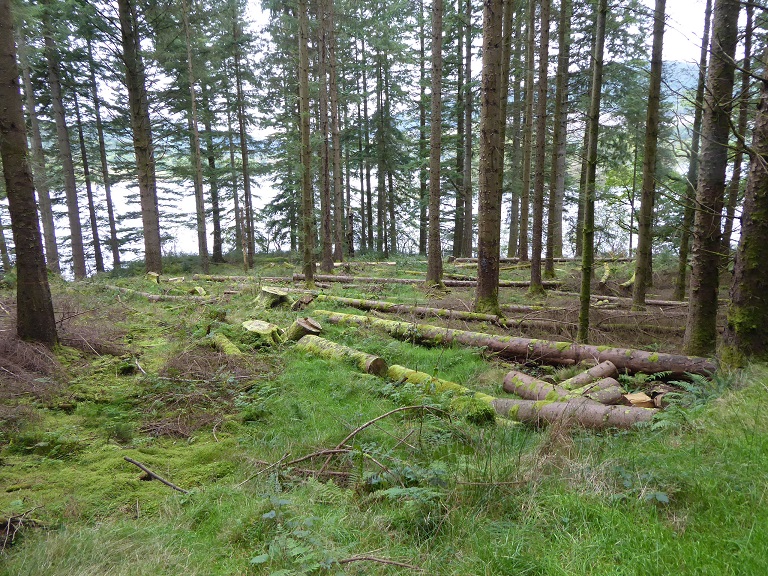
This appears unlikely, however, to create more places where it might be possible to camp due to Forest and Land Scotland’s practice of abandoning perfectly good and usable felled wood, leaving it in place. Its almost as though its designed to keep people out.
We did, however, spot two more places below the road where it might just be possible to camp:
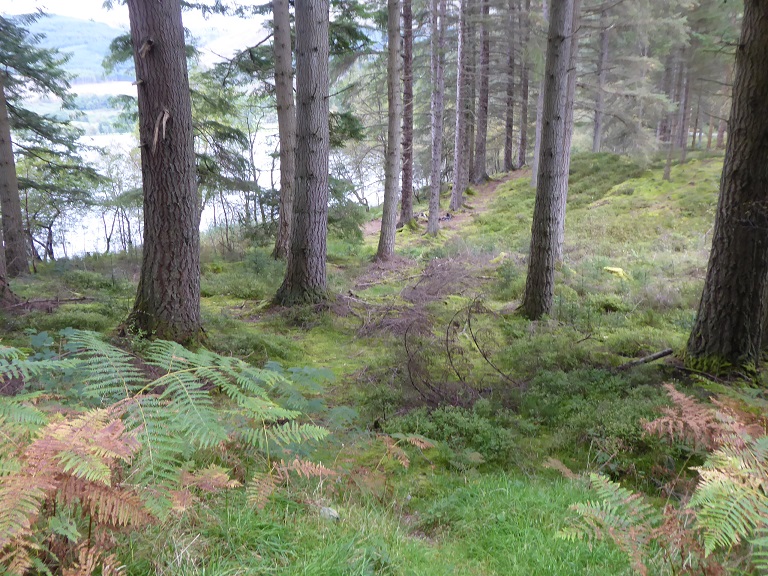
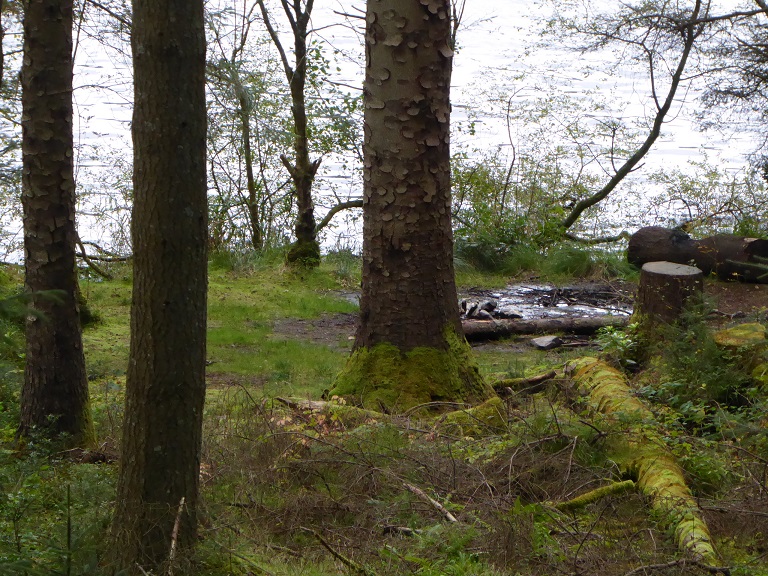
Neither spot looked enticing but then I guess the main people likely to camp here are anglers, hardy folk, who will put up with considerable discomfort to be able to fish.
Whether these four spots in the Couligartan permit area, and the only places left where anglers on Loch Ard can now camp and fish, are any good for fishing I am not qualified to say. I don’t believe, however, the permit areas were designed with walkers, anglers or anyone else who camps in mind. They were all about the LLTNPA being able to show pretty maps to our politicians in order to persuade them they had allowed adequate space around the main lochs in the National Park for people to continue camping. The Couligartan permit area provides further proof that this provision has never been adequate and the power to decide where people should be able to camp should never have been handed over to the LLTNPA.
Couligartan – the wider context
As you leave Kinlochard onto the Couligartan track you pass one of the LLTNPA’s standard warning signs that you are in a camping management zone and need a permit to camp.
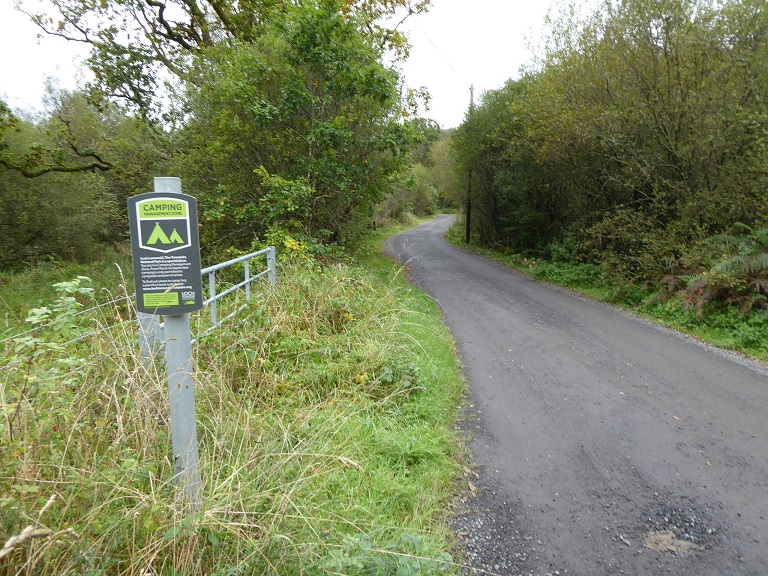
The creation of the camping byelaws not only removed any incentive landowners previously had to co-operate with provision for campers – the main explanation for why the LLTNPA has been unable to create more camping permit areas – it also seems to have encouraged more landowners to try and block off other access rights.
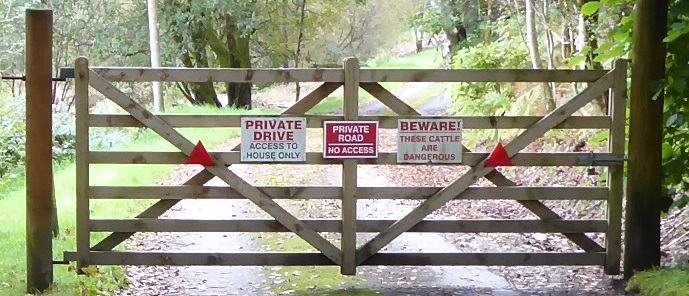
The gate to the 200m road down to Couligartan House is a shocker. Not only was the gate locked – an obstruction in terms of access rights (people who are frail or who have disabilities have the same access rights as able bodied people able to climb over gates like this) – multiple signs make the message very clear. Woe betide you if you cross the gate!
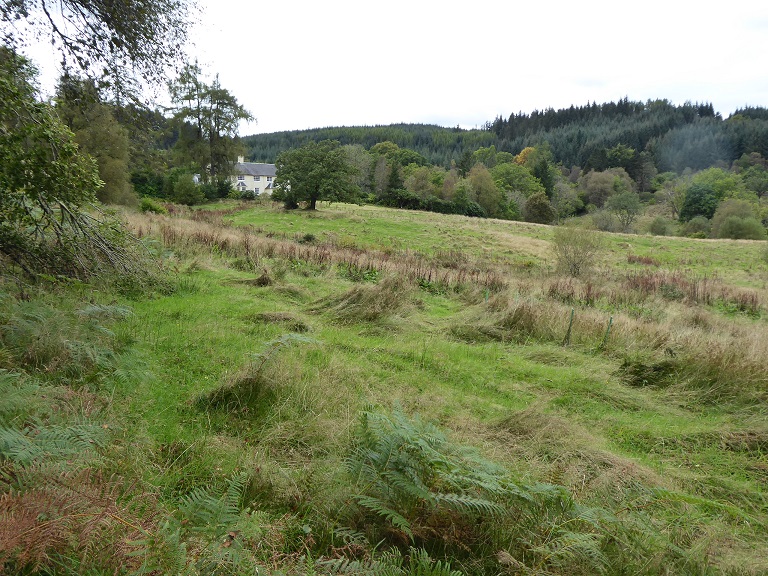
Running between Couligartan House and the edge of Loch Ard there is a clearing in forest, with open fields running down to the loch shore (which is scrubby and boggy) where access rights apply. This land, however, is very hard to access because of the barbed wire fence and while there is another gate, it too is locked:
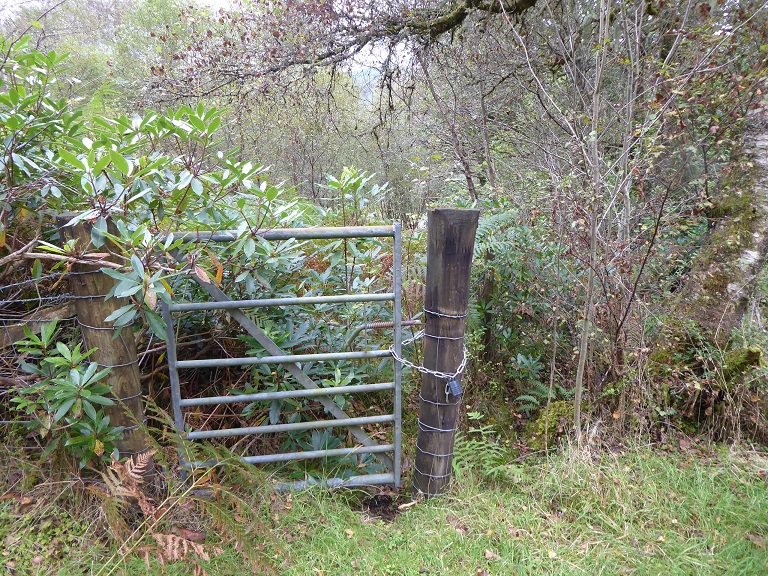
Now, I can understand someone not wanting people to walk right up to their front door but there are easy solutions to this which respect access rights. The owners could either direct people to the open fields part way down the track to their house or to put a sign on the gate saying “please access open fields below house from other side” and then install a gate there. They have done neither and clearly don’t want people on their property.
Seeing this, I wondered whether the Park Rangers, who must come down this track regularly to check whether people in the camping permit area have permits – just think how much pollution that is creating and for what? – had reported the issues (they have failed to do so with other cases I have reported). When I got home I was delighted to find that a report on Couligartan House had been provided to the August meeting of the Local Access Forum and the Park’s Access Officers are on the case:

This helps prove my contention that the introduction of the camping byelaws have been a green flag to landowners to undermine access rights. But well done the LLTNPA Access Team for getting most of the signs removed and, if was a Ranger who reported them, well done to that Ranger!
In the same report to the Local Access Forum the Access Team reported they had been working with their planning colleagues to removed access obstruction from a new development on the other side of Loch Ard. Again, that is a really welcome development and its good that planners now appear to be working more closely with the access team to enforce access rights.
Significant problems, however, remain on that shore. I will cover what’s been happening at the Drumlean Estate, which was subject to a historic court judgement last year (see here) and (here), in a further post. But here are photos of two signs by the track to Ledard Farm owned by former Board Member Fergus Wood. Both contrary to access rights:
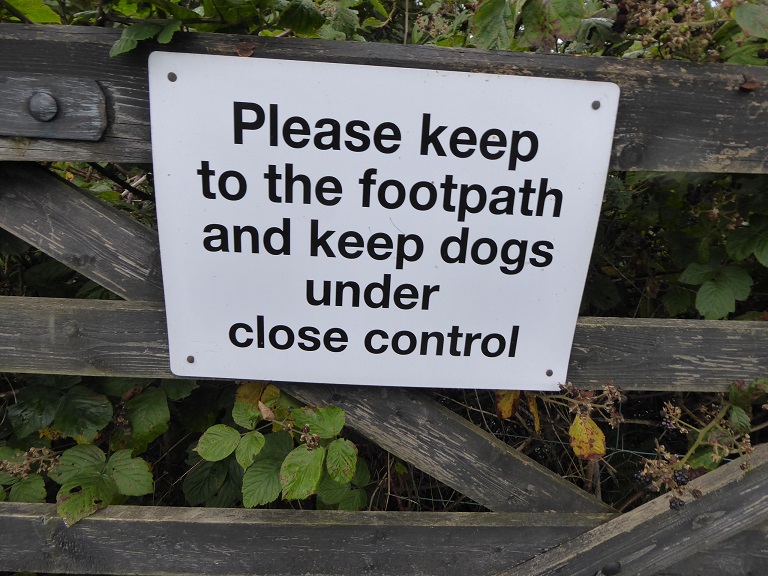
Access rights extend to all land and not just paths. Keep to the path signs have been profilerating ever since the Cairngorms National Park Authority endorsed this message in the Welcome to the Moor (but only if you don’t walk over most of them) signs (see here for example).
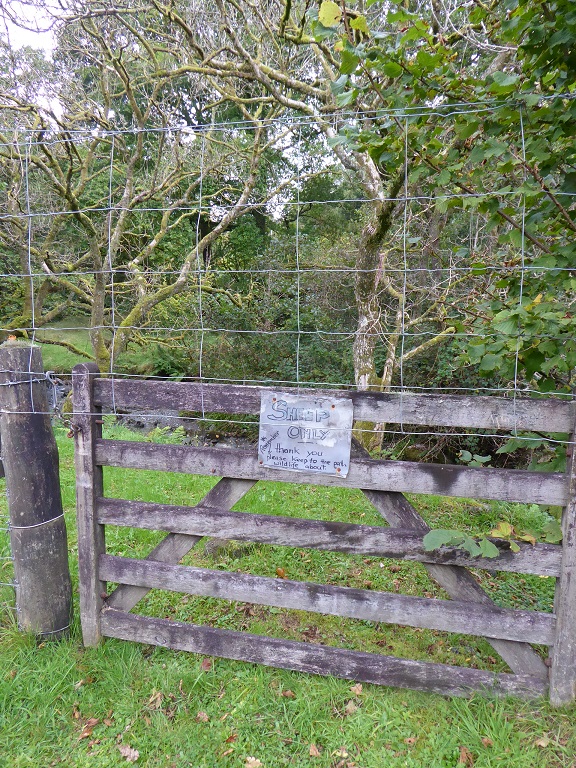
The idea that you need to keep to the path to protect wildlife is pernicious. Sheep do far more to degrade habitats and their presence does far more to explain the lack of wildlife in much of the National Park than walkers do – but landowners just can’t help themselves. They still see ownership of property conferring exclusive rights to the land.
The camping byelaws – what next?
If we don’t fight for our access rights we will lose them. That’s why its so important that now three years of the camping byelaws are finished and the LLTNPA has to report to Scottish Ministers on their impact that all who care about access rights campaign so that they are not renewed.
Parkswatch will be covering this a lot more over the next few months as its so important. It is in fact what prompted me to set up the blog three and a half years ago!
This blog should be compulsory reading for government officials. It’s the usual story: most politicians are not interested and will be happily fobbed off with whatever rubbish the LLTNPA wants to punt. Perhaps the main problem, though, is that most people have no real idea of what their access rights are and how they should respond to the scenarios you describe. Walkers’ organisations should run tutorials in the subject!
Government officials are the problem they dont understand .young people walking the west highland way can’t camp at the loch using small tents and stoves just for a night it’s all wrong. The LLTNPA and the Forestry commission should be working together building small log cabins and working with our young people teaching young people how to respect woods lochs and hills my own personal feeling when on the Loch kayaking is the LLTNPA don’t want you their
Bill
Yes one of the absolute failures of the LLTNPA has been to do anything to promote the hutting movement. There are great tracts of industrial forest in the National Park close to the Glasgow conurbation and Forth Valley which need to be diversified and provide plenty of space for hutting yet nothing……………..